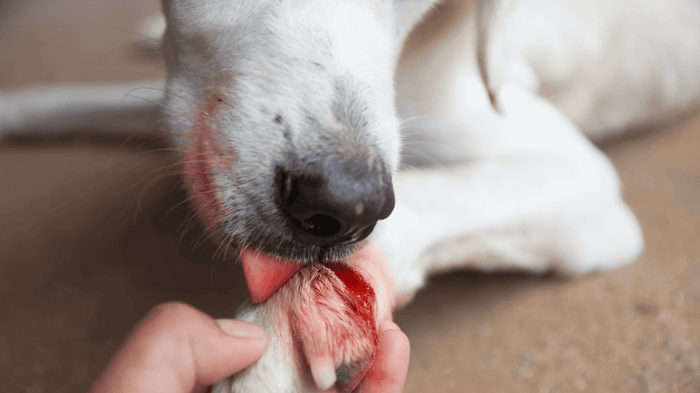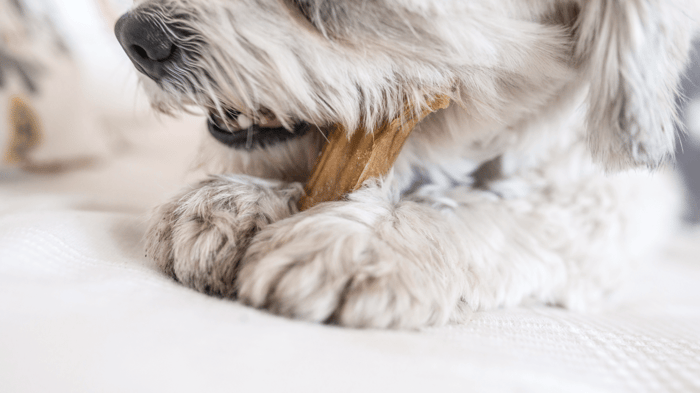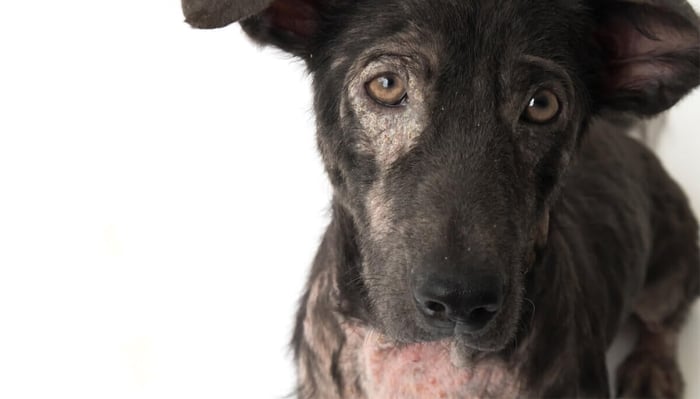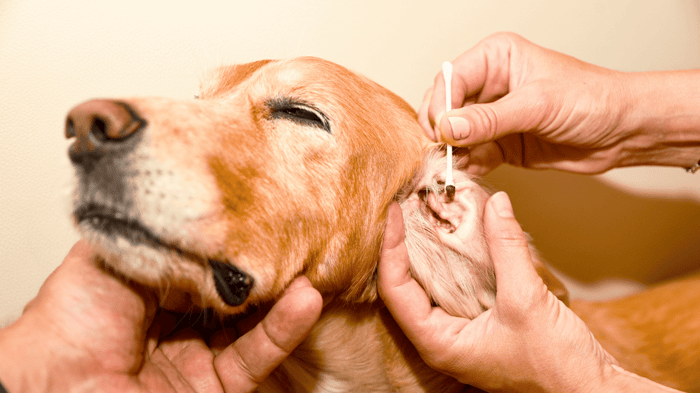When a dog gets injured, it’s important to know how to properly care for their wound. One of the first things pet owners may wonder is what they can put on a dog wound. The answer to this question is not always straightforward, as the type of wound and severity of the injury can impact the best course of treatment.
For minor wounds, such as small cuts or scrapes, it’s generally safe to use wipes formulated for a dog’s skin to clean the area and prevent infection. These wipes are designed to be gentle on a dog’s skin and can effectively remove dirt and debris. However, for more serious wounds, it’s important to seek veterinary care to ensure proper treatment and prevent complications.
To give you the best advice on what to put on a dog’s open wound, we have consulted sources like Dr. Kevin P. Winkler, DVM and the BSAVA Guide To Canine Wound Care.
So, What Can I Put on a Dog’s Wound?
For a minor dog wound, first clean it with warm water and mild soap. After patting dry, apply an antibiotic ointment like Neosporin. Avoid using products like hydrogen peroxide, which can impede healing. For deep or serious wounds, or if signs of infection appear, consult a veterinarian immediately.
In other words, when a dog gets injured, it’s important to treat the wound to prevent infection and promote healing. You also need to comfort your dog when they are in pain.
First and foremost, it’s important to clean the wound with a mild antiseptic solution to remove any dirt or debris. A saline solution or diluted betadine solution can be used for this purpose.
After cleaning the wound, you may apply a topical antibiotic ointment to help prevent infection. Some commonly used topical antibiotics for dogs include Neosporin, Polysporin, and Bacitracin. However, it’s important to note that some dogs may be allergic to certain types of antibiotics, so it’s best to consult with a veterinarian before applying any medication.
In addition to topical antibiotics, there are also natural remedies that can be used to help promote healing. Honey, for example, has been shown to have antibacterial properties and can be applied directly to the wound. Aloe vera gel can also be applied to help soothe the skin and promote healing.
It’s important to note that some products, such as hydrogen peroxide, can actually be harmful to a dog’s wound and should be avoided. Additionally, if a wound is deep or shows signs of infection, it’s best to seek veterinary care for proper treatment.
Overall, while there are a variety of products that can be used to treat a dog’s wound, it’s important to consult with a veterinarian to determine the best course of action for your pet’s specific needs.
Identifying Dog Wounds (Types of Wounds & Severity)

When it comes to identifying dog wounds, it’s important to understand the different types of wounds and their severity. Some wounds may require immediate attention from a veterinarian, while others can be treated at home.
Types of Wounds
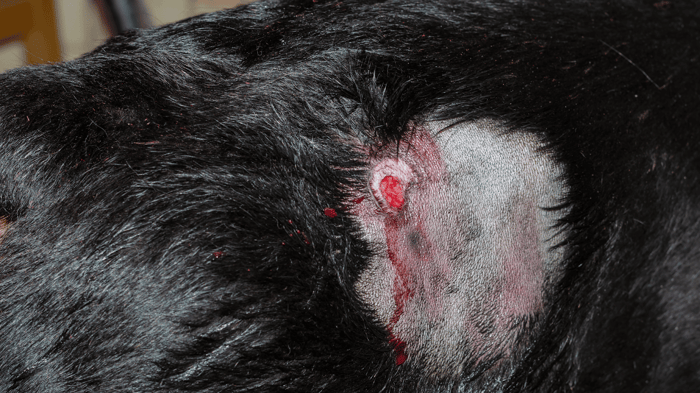
There are several types of wounds that dogs can experience, including:
- Abrasions: These are superficial wounds that typically involve the top layer of skin. They can be caused by rubbing against a rough surface, such as concrete or asphalt.
- Lacerations: These are deeper wounds that involve tearing of the skin and underlying tissues. They can be caused by sharp objects or trauma.
- Punctures: These are wounds that are caused by a puncture or bite from another animal. They can be difficult to detect and may require medical attention.
We will look at other common injuries and wounds on dogs below and what to put on them.
Severity of Wounds
The severity of a dog’s wound can vary based on the type of wound and the extent of the damage. Some wounds may only require basic first aid, while others may require surgery or other medical treatment.
Minor wounds, such as abrasions or small lacerations, can often be treated at home with basic first aid. This may include cleaning the wound with soap and water, applying an antiseptic ointment, and covering the wound with a bandage.
More severe wounds, such as deep lacerations or puncture wounds, may require medical attention. These wounds may need to be cleaned and debrided, and the dog may need antibiotics or other medications to prevent infection.
It’s important to keep an eye on any wounds your dog may have and seek medical attention if you notice any signs of infection or if the wound does not seem to be healing properly.
For all wounds, maintain cleanliness and protect from debris. In doubt? Always consult professional advice.
Can I use NSAIDs For My Wounded or Injured Dogs?
Administering NSAIDs (non-steroidal anti-inflammatory drugs) to dogs might seem like a good idea for pain relief, but caution is required. A study found that NSAIDs can slow the healing process, including bone injuries. They might inhibit certain cellular activities vital for recovery. Before giving any medication, always check with your veterinarian. Common NSAIDs for dogs include:
- Rimadyl (active ingredient: carprofen);
- Deramaxx (active ingredient: deracoxib);
- Previcox (active ingredient: firocoxib); and
- Metacam (active ingredient: meloxicam).
Immediate Actions After A Dog is Wounded Or Injured
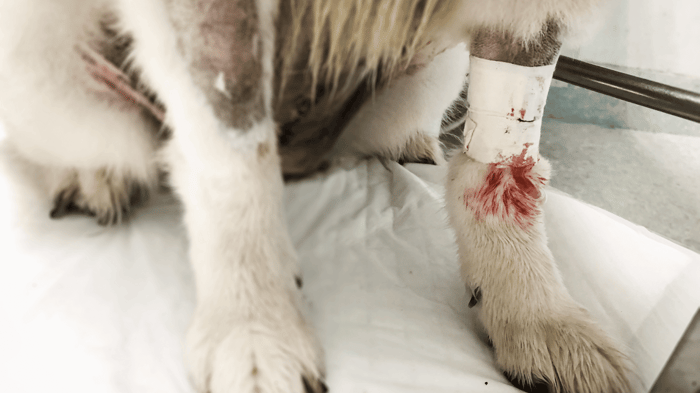
When a dog gets an injury, it’s essential to take immediate action to prevent further damage and promote healing. Here are some actions that can be taken:
- Apply Pressure: If the wound is bleeding, apply pressure with a clean cloth or gauze to stop the bleeding. Keep the pressure for at least 5 minutes until the bleeding stops.
- Clean the Wound: Use a sterile saline solution or clean water to clean the wound. Avoid using hydrogen peroxide or alcohol, as it can cause further damage to the tissue.
- Basic Bandaging: Once the wound is clean, cover it with a sterile bandage or gauze to protect it from further contamination. Make sure the bandage is not too tight, as it can restrict blood flow.
It’s important to note that these actions are only temporary. It’s crucial to seek veterinary care as soon as possible to ensure proper treatment.
Topical Applications
When it comes to treating a dog wound, topical applications can be a great option. Here are some of the most commonly used topical applications for treating dog wounds.
Antibiotic Ointments
Antibiotic ointments are a popular choice for treating dog wounds. They can help prevent infection and promote healing. Some popular antibiotic ointments for dogs include:
- Neosporin;
- Triple Antibiotic Ointment; and
- Bacitracin.
When applying antibiotic ointment, make sure to clean the wound thoroughly first. Then, apply a thin layer of the ointment to the wound and cover it with a bandage.
Antiseptic Cream and Antibacterial Cream
Antiseptic cream and antibacterial cream can also be used to treat dog wounds. They can help prevent infection and promote healing. Some popular options include:
- Betadine;
- Chlorhexidine; and
- Silver sulfadiazine.
When using antiseptic or antibacterial cream, make sure to clean the wound thoroughly first. Then, apply a thin layer of the cream to the wound and cover it with a bandage.
Aloe Vera
Aloe vera is a natural remedy that can be used to treat dog wounds. It has anti-inflammatory properties and can help soothe the skin. Here are some tips for using aloe vera on a dog wound:
- Cut a fresh aloe vera leaf and extract the gel.
- Apply the gel to the wound.
- Cover the wound with a bandage.
Overall, there are many topical applications that can be used to treat dog wounds. It’s important to choose the right one based on the severity of the wound and your dog’s individual needs.
Non-Topical Applications
When a dog has a wound, there are various non-topical applications that can be used to aid in the healing process. These applications can help prevent infections, reduce pain, and promote faster healing. Non-topical applications include oral antibiotics and pain relievers.
Oral Antibiotics
Oral antibiotics are commonly prescribed by veterinarians to prevent infections in dog wounds. These antibiotics are available in different forms, including tablets, capsules, and liquids. The type of antibiotic prescribed will depend on the severity of the wound and the type of bacteria present.
It is important to follow the veterinarian’s instructions when administering oral antibiotics to a dog. It is also important to complete the full course of antibiotics, even if the wound appears to have healed, to prevent the development of antibiotic-resistant bacteria.
Pain Relievers (That Are Safe For Dogs)
Pain relievers can help reduce the discomfort associated with dog wounds. There are various types of pain relievers available, including non-steroidal anti-inflammatory drugs (NSAIDs) and opioids. NSAIDs are commonly used for mild to moderate pain, while opioids are used for severe pain. However, remember to speak to your vet because as stated above, NSAIDs can actually delay wound healing.
It is important to note that not all pain relievers are safe for dogs. Some human pain relievers, such as acetaminophen and ibuprofen, can be toxic to dogs and should never be used without veterinary supervision.
In conclusion, non-topical applications such as oral antibiotics and pain relievers can be used to aid in the healing process of dog wounds. It is important to follow the veterinarian’s instructions when administering these applications and to only use medications that have been prescribed or recommended by a veterinarian.
Natural Remedies For Dog Wounds

When it comes to treating dog wounds, natural remedies can be an effective and safe option. Here are some natural remedies that can help heal your dog’s wounds:
Honey
Honey has long been known for its healing powers. A recent NCBI study shows that it’s great for treating various wounds, from burns to scratches. This is because honey is packed with helpful compounds like flavonoids and vitamins that speed up healing. For dog owners, using honey can be a natural way to treat minor injuries on their pets. It can help fight off bacteria and support quicker healing. But always check with a vet before using honey or any other home remedy on your furry friend.
Colloidal silver
Colloidal silver is a natural antibiotic that can help prevent infection and promote healing. Apply a small amount of colloidal silver directly to the wound and cover with a bandage. Change the bandage and reapply colloidal silver twice a day until the wound has healed.
However, remember that some studies show that colloidal silver has no real benefit for fighting pathogens. So, It’s best to be cautious and research colloidal silver carefully before using it.
Turmeric
Curcumin, a natural substance from turmeric, has been recognized since ancient times in Ayurveda for its healing abilities. A recent study reveals that curcumin helps reduce inflammation, clear harmful oxygen particles, and speeds up wound recovery by enhancing collagen growth. However, its fast metabolism and low solubility have restricted its use in wound care.
Modern science is turning to nanotechnology to overcome these challenges. By creating tiny carriers like nanoparticles and liposomes loaded with curcumin, targeted delivery directly to wounds is achieved, enhancing its effectiveness..
Calendula
Calendula, commonly known as marigold, is a herb with roots in the Mediterranean. It’s traditionally hailed for its wound-healing and anti-inflammatory qualities. A research study using flowers from Brazil-tested calendula extracts highlighted its ability to support skin repair.
The study found that calendula not only reduces inflammation and fights bacteria but also boosts blood vessel formation and aids in the skin’s healing process. This makes calendula a promising natural remedy for wound care and recovery.
Marshmallow root
Marshmallow root, scientifically known as Althaea officinalis L., has been traditionally explored for its medicinal benefits. A research study aimed to evaluate its potential in treating wound infections, considering the side effects of chemically synthesized drugs.
The study indicated that while marshmallow root extract might not be effective against gram-negative bacteria, it showed promising results against gram-positive bacteria. Additionally, when applied topically to wounds in rats, there was a significant improvement in wound healing compared to untreated wounds. In essence, marshmallow root might offer a natural alternative for treating gram-positive infections and aiding wound recovery.
What to Put on Different Types of Dog Wounds
Using insights from Dr. Andrew Linklater, DVM as found on the MSD Vet Manual:
Dog Injury Treatment Guide
| Injury Type | Treatment | Medication/Additional Care |
| Broken Nails | Control bleeding using styptic powder, cornstarch, or white flour. If broken piece remains, seek vet help. | Clean area to prevent infection. |
| Bumps, Bruises, Twists, Sprains | Cold compress initially, then warm compresses. | If symptoms persist, seek vet for pain relief. |
| Fish Hooks | After safe removal, clean area with antiseptic. | Deeply embedded hooks need professional attention. |
| Insect Bites/Stings | Cold pack for swelling. Scrape out stinger without squeezing. | Mild antihistamine for allergic reactions (consult vet). |
| Porcupine Quills | Only professional removal recommended. | Apply antibiotic ointment post-removal based on vet advice. |
| Skunking | Flush eyes/mouth with water if contacted. Use de-skunking products for the coat. | Avoid eye/face area with rinses. |
| Swallowed Objects | Vet evaluation especially for sharp objects. Also see: what to do if a dog is choking. | Anti-emetic (anti nausea or vomiting medication) or specific treatment if recommended by vet. |
| Cuts/Tears (Lacerations) | Clean with saline or mild antiseptic. Protect with sterile bandage. Deep cuts need vet attention. | Possible antibiotics and pain relievers. |
| Bite Wounds | Clean thoroughly. Drainage tubes or stitches might be needed for deep bites. | Antibiotics post-culture and pain relief as necessary. |
| Degloving Injuries | Urgent vet care. May need debridement and flushing. | Broad-spectrum antibiotics and pain relief. |
| Gunshot Injuries | Immediate vet evaluation. Clean external wound. | Antibiotics due to wound contamination and pain relief. |
| Pressure Wounds | Regular cleaning and pressure relief. Severe cases might need surgery. | Topical treatments, antibiotics, and pain relief as needed. |
Note: This table provides general recommendations. Always consult with a veterinarian for specific injuries and appropriate care.
Dog Wound Dressings
When it comes to treating a dog wound, choosing the right dressing is essential to promote healing and prevent infection. Here are some common wound dressings that can be used on a dog wound:
- Non-stick pads: These are ideal for wounds that are oozing or bleeding. They are designed to prevent the pad from sticking to the wound and causing further damage.
- Gauze: Gauze is a versatile dressing that can be used to cover a wound or to pack a deep wound. It is absorbent and can help to keep the wound clean.
- Self-adhesive bandages: These are useful for securing dressings in place without the need for tape or clips. They are also flexible and comfortable for the dog to wear.
- Hydrocolloid dressings: These dressings are designed to provide a moist environment for the wound to heal. They are ideal for wounds that are slow to heal or for wounds that are prone to infection.
- Silver dressings: Silver dressings are designed to provide antimicrobial protection to the wound. They can help to prevent infection and promote healing.
When choosing a wound dressing, it is important to consider the type and severity of the wound, as well as the dog’s individual needs. It is always best to consult with a veterinarian to determine the most appropriate dressing for your dog’s wound.
See this article if your dog has had stitches that opened up.
Remember to keep your dog from licking their wound, as their tongues may help clean the wound a bit, they may still cause an infection. See: Are Dogs’ Tongues Clean? Exploring the Facts
When to Seek Veterinary Help
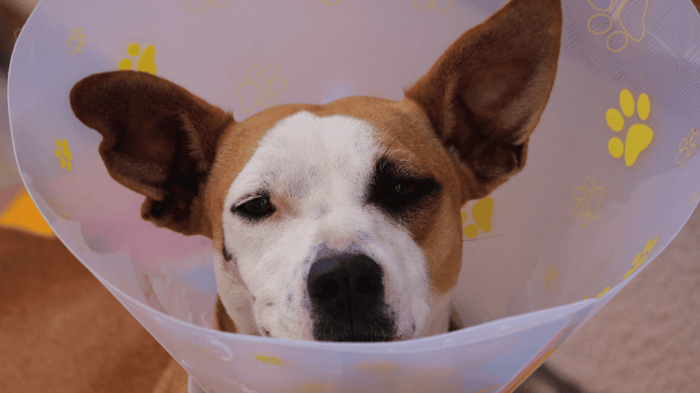
If a dog’s wound is severe or shows signs of infection, it is important to seek veterinary help. Here are some signs that indicate a dog’s wound requires professional attention:
- The wound is deep and bleeding heavily;
- The wound is located near the eye or on the face;
- The wound is showing signs of infection, such as redness, swelling, or discharge;
- The dog is in severe pain or discomfort; or
- The dog is lethargic or showing signs of illness.
If any of these signs are present, it is recommended to take the dog to a veterinarian as soon as possible. Delaying treatment can lead to complications and may worsen the dog’s condition.
In addition, it is important to seek veterinary help if the dog has any underlying medical conditions or is taking medication that may affect wound healing. The veterinarian can provide proper care and medication to ensure the wound heals correctly and prevent any further complications.
Overall, seeking veterinary help for a dog’s wound is crucial to ensure proper healing and prevent any potential health risks.
Preventing Future Wounds
Regular exercise
Supervision
Proper nutrition
Regular grooming
Proper training
Safe environment
By following these tips, you can help reduce the risk of your dog getting injured and prevent future wounds.
Frequently Asked Questions
How can I safely clean a wound on my dog?
What are some effective home remedies for treating dog wounds?
Can I use human antiseptics like Neosporin on my dog’s wound?
What are some signs of infection in a dog’s wound?
Are there any natural alternatives to commercial wound ointments for dogs?
What is the recommended way to bandage a dog’s wound?
Final Thoughts
Overall, there are several options for what can be put on a dog wound. It is important to consult with a veterinarian before applying any treatments to ensure that the wound is properly cleaned and treated.
In general, it is best to avoid using any home remedies or over-the-counter products without first consulting with a vet. These treatments may not be suitable for all types of wounds and could potentially cause further harm to the animal.
If a dog has a minor wound, such as a small cut or scrape, it may be possible to clean the area with warm water and apply a small amount of antibiotic ointment. However, for more serious injuries, it is important to seek veterinary care as soon as possible.
In some cases, a veterinarian may recommend the use of a specialized wound dressing or bandage to help promote healing and prevent infection. These products should only be used as directed and under the guidance of a veterinary professional.
Overall, the key to successfully treating a dog wound is to seek prompt veterinary care and follow the recommended treatment plan. With proper care and attention, most wounds can be effectively treated and the animal can make a full recovery.


